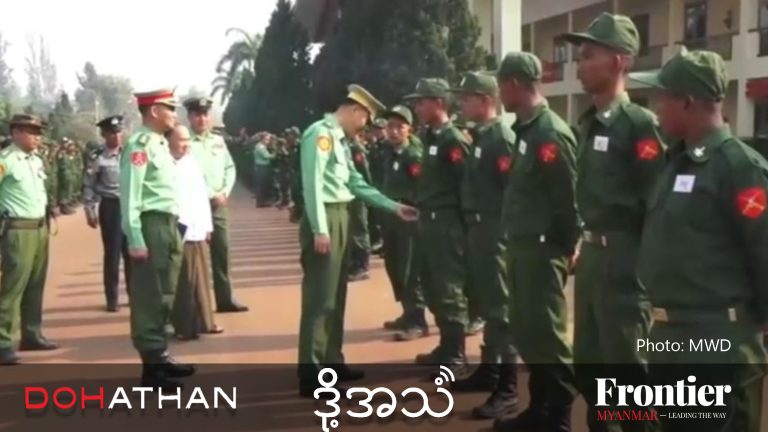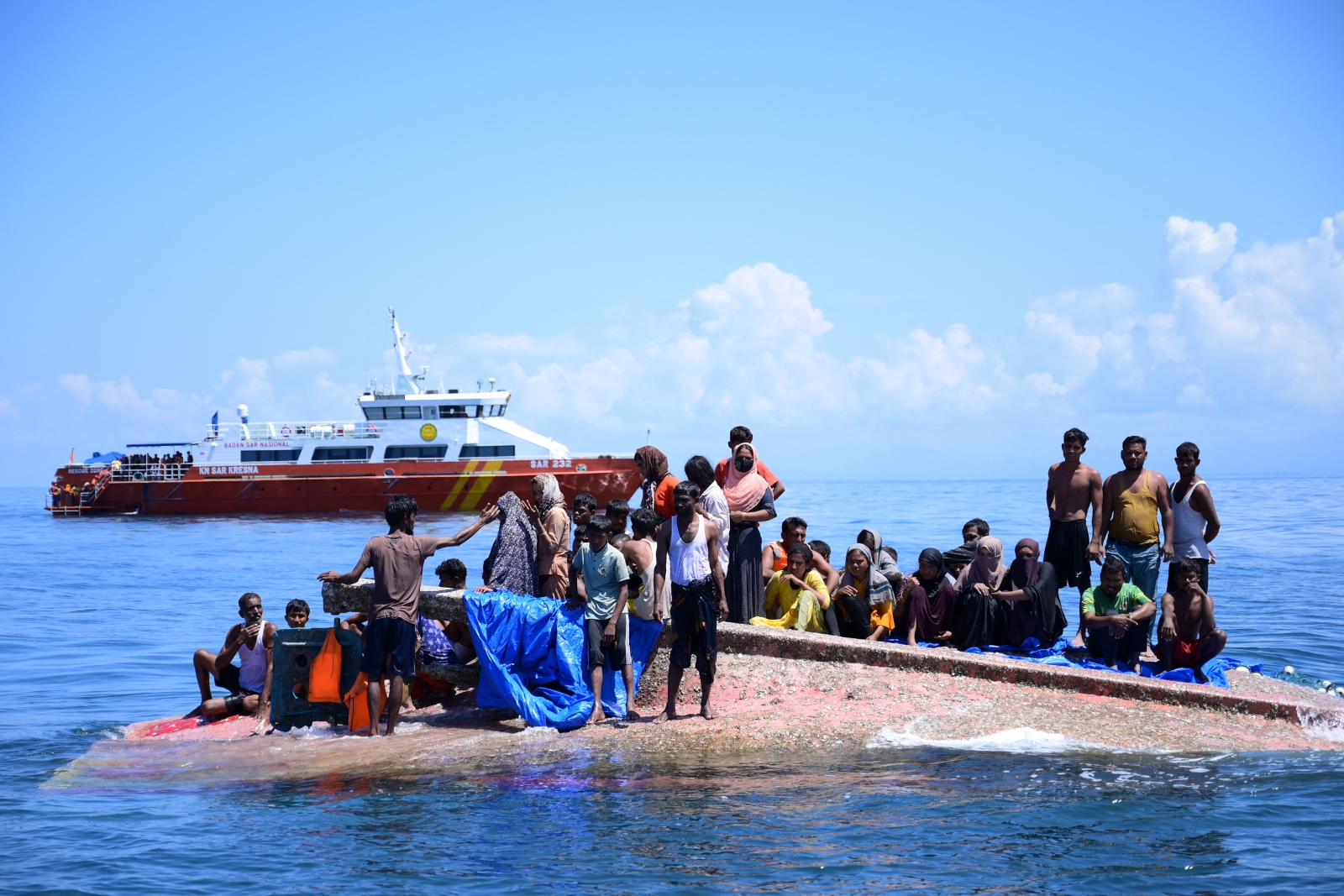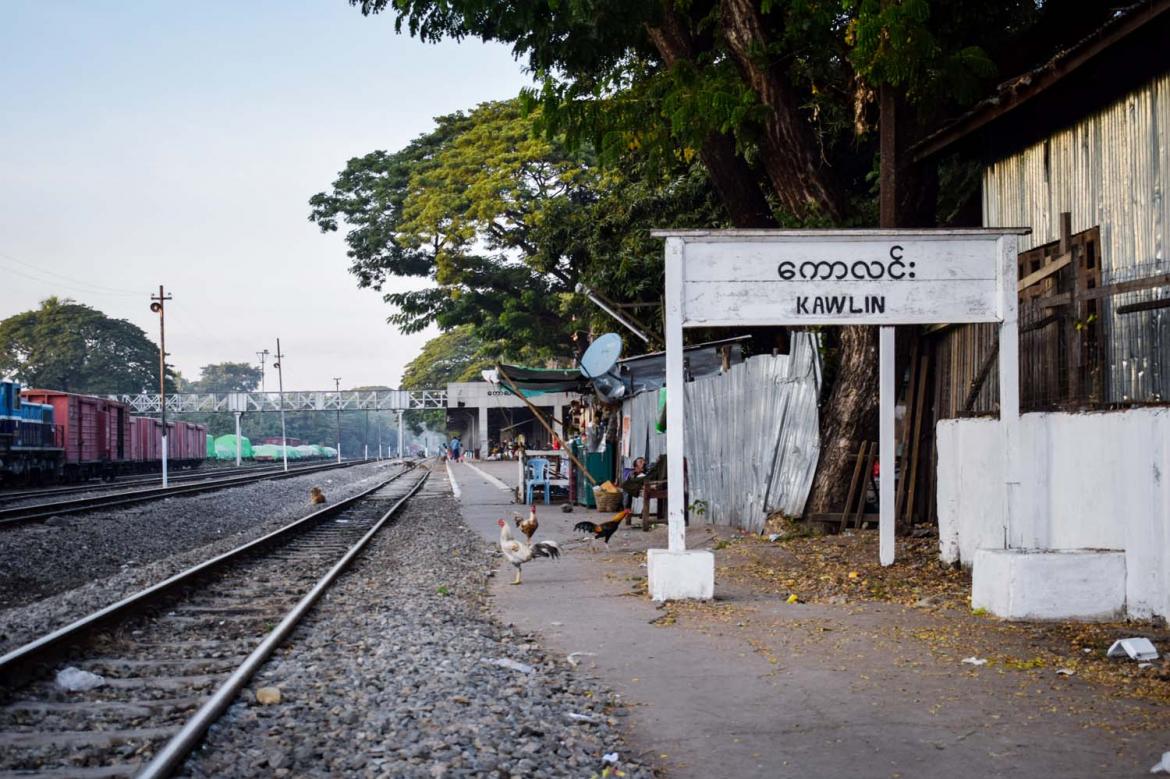Smaller minority groups in Rakhine State are caught between the regime and the Arakan Army, and seen with distrust by both sides, as conflict and displacement threaten their ways of life.
By FRONTIER
For the first three decades of her life, Par Chay village was the only home Ma Hla Hla Htay* had ever known. She and her husband, both paddy farmers, hoped to bring up their young son in this small settlement in Rakhine State’s Kyauktaw Township, following the traditional, centuries-long customs of their ancestors.
But in December 2018, fighting between the Arakan Army and Myanmar military steadily descended on Par Chay.
“They were firing light and heavy weapons at each other. The sound of shooting was very noisy. Then, towards the end of the month, military planes dropped bombs near our village,” recalled Hla Hla Htay, now 35. “At that time, we became very scared, and we decided to flee. The whole population left.”
They relocated to a camp for internally displaced people in Taung Min Ku Lar village, also in Kyauktaw.
“It has been nearly six years since we arrived here,” Hla Hla Htay told Frontier, saying by now her abandoned home has likely fallen into disrepair. “No one in the whole village dares to return.”
Par Chay’s population was ethnic Mro, a minority that has often found itself caught in the crossfire of the conflicts in Rakhine.
“War brings nothing good for us,” said Ko Thura*, a Mro social welfare worker from Mrauk-U Township whose organisation focuses on Mro IDPs.
“When wars happen, everyone in Rakhine suffers. But we suffer more,” he said, adding that more than 5,000 Mro fled the conflict between 2018 and 2021, according to data collected by his organisation, whose name he requested to withhold for security reasons.
Fighting between the AA and the military regime has rapidly escalated since November last year, with the AA capturing several towns and townships in northern Rakhine.
“Now, the number of Mro IDPs is even higher because war is taking place in all Mro areas,” Ko Thura said.
But conflict and displacement aren’t the only dangers stalking the Mro community. Both the AA and the Tatmadaw view the minority group with distrust, and have detained or questioned individuals on suspicion of supporting the other side. Some Mro have even allegedly been forcibly conscripted into the AA.
“We are oppressed from both sides,” Ko Thura said.
Forced to flee
The Mro are an ethnolinguistic Chin group who mostly live in northern Rakhine and southern Chin State, but their exact numbers are unknown. The ethnicity breakdown for the latest Myanmar census, conducted in 2014, has never been made public, but according to the 1983 census, all Chin groups together made up 3.2 percent of the total population in Rakhine. Ko Thura claimed there are now about 80,000 Mro there, out of a total population of over 2 million.
To this day, the Mro maintain their distinct language and customs, including an ancient ritual bull sacrifice to spirit guardians believed to protect their farmland. Most are Buddhist, with a smaller Christian minority, both imbued with older animist beliefs.
Traditionally, they have lived in remote rural areas, where most conflict in Myanmar was concentrated until very recently, when fighting began to penetrate into major towns.
“We used to live in the forests and the hills. Then war started in those areas, so we’re suffering more than other ethnic groups,” Ko Thura said.

Even when the fighting is over, danger remains, in the form of landmines and unexploded ordnance.
“We are farmers, and during the rainy season we go into the forest to harvest bamboo. But there are many landmines there, so displaced Mro are unable to return to their homes even after the fighting stops,” said Hla Hla Htay.
“We also understand that ceasefires can be temporary. That’s why we have stayed in the IDP camp,” she added. The AA has agreed to two informal ceasefires with the military, one in 2020 and another in 2022, but both eventually broke down, leading to renewed fierce clashes.
Living in displacement camps for extended periods raises its own difficulties.
“We were in the camp during the COVID-19 pandemic. Our area is very crowded, and many people were infected,” she said.
Then, in May last year, Cyclone Mocha ravaged Rakhine. The severe storm destroyed all the shelters in the camp, and just as they finished rebuilding them, the war resumed. In December, junta troops fired artillery towards nearby AA positions, and shell fragments fell on the Taung Min Ku Lar IDP camp.
“We ran again. Children and pregnant women fled by boat, but everyone else had to walk. We stayed away from our camp for a week,” Hla Hla Htay said.
Caught in the middle
Displacement is not the only difficulty faced by the Mro. Caught in the middle of the conflict, they often find themselves threatened by soldiers on both sides.
“We didn’t take sides when the fighting started. The AA came to ask for food and we gave it to them. Then the military came and asked for food too. The AA troops thought we supported the military, and the military thought we were on the side of the AA, so both sides arrested Mro people,” Ko Thura said.
The 2019 arrest of Mro Christian pastor U Tun Nu in Taung Min Ku Lar village by AA troops came as a particularly big shock.
“The AA said he was a military informant,” Ko Thura said. “After he was arrested, his family members were unable to contact him. They tried very hard, but they couldn’t get any information about him. So we thought he had died and we held a prayer ceremony for him.”
However, on March 7, 2020, the AA finally released the pastor, who then moved to Yangon with his family.
“He didn’t say anything when asked about his arrest. He doesn’t live in Rakhine State anymore. He suffered a lot of emotional trauma,” Ko Thura said.
In 2022, before fighting resumed that year, the Myanmar military embarked on a widespread arrest campaign in Rakhine, seemingly hoping to cripple the AA’s budding administration.
Among the detainees was a 40-year-old Mro man from Taung Min Ku Lar, who was arrested by the regime in January that year after being found with K6 million in cash (about US$1,600 at the market rate).
Ma Thiri*, a resident of Taung Min Ku Lar, said the money was from remittances sent by his children working abroad.
“The military seized him, and they said that his money was being used to support the AA. But we don’t support either side. We just want to live in peace,” she said.
After his arrest, community leader U Kyaw Ko* went to the battalion base and tried to explain that the man with the cash had no links with the AA.
“But the military arrested [Kyaw Ko] too. And they beat both of them,” alleged Ma Thiri, who was one of Kyaw Ko’s neighbours. “He got several injuries, and then they imprisoned him.”
Both men were released after about one year in prison.
Ko Thura said many other Mro people have been arrested in similar incidents by soldiers on both sides, but most victims remain silent out of fear of retaliation.
“Many more cases have happened. We lost our homes. And we got arrested. The Mro people have suffered a lot in this conflict,” he said.

Daw Thu Zar*, who works with another Mro charitable organisation, said that in the social hierarchy in Rakhine, the Mro are akin to the youngest brother in a family.
“The Mro are like the youngest. We have to be scared of the oldest brother – the military – and we are also afraid of the AA – the middle brother – because we are the weakest in the family,” she said.
But the Mro are at least part of the proverbial family, as an officially recognised indigenous group in Myanmar. The Rohingya, who also live in northern Rakhine, are not. As a result, hundreds of thousands have been violently expelled to Bangladesh, and those that remain are denied citizenship and subjected to conditions that major human rights groups describe as apartheid.
The Rohingya have also suffered from being caught in the middle of the conflict, with the situation further deteriorating in recent months as some have been forcibly conscripted by the military to fight the AA.
‘We will keep watching them’
But the Mro say they’ve been forcibly conscripted into the AA.
As the fighting continues, the AA has strengthened its forces in northern Rakhine and has appointed ethnic minorities, including Rohingya and Mro, to some positions in its civilian administration.
“They have appointed Mro administrators in Mro villages, and we appreciate that,” Thu Zar said.
But often, when ethnic armed groups conquer new territories, they expect their new subjects to contribute, often in the form of taxes or troops. According to residents of multiple villages under AA control, the group has started forcibly recruiting some Mro to fight in its war against the regime.
Ko Zaw Oo*, a resident of Buthidaung Township who requested to withhold his village’s name for security reasons, said that each Mro village in the township is required to send 10 people to serve in the AA.
“The AA started gathering recruits in December when the fighting with the military was very intense,” he said.
Ko Thura confirmed that there are now Mro soldiers in the AA, adding that most were forced into service.
“Most Mro don’t want to join,” he said.
Thu Zar said the AA was also recruiting from Mro villages in Kyauktaw, with five people being taken from each village to serve as soldiers or to carry food for the other troops.
“They shouldn’t be pressuring our people to join the Arakan Army,” she said.
The AA did not respond to Frontier’s requests for comment.
Ko Thura said the Mro would like more clarity about the AA’s policies concerning ethnic minorities.
“We have no objection to the appearance of the AA. It’s very good for the Rakhine ethnic group. But it’s not good for them to rely on weapons and bully ethnic minorities. We don’t want that,” he said. “I want them to be clear about their policies concerning minorities like us.”
Mro residents of northern Rakhine are hopeful things would improve if the AA took full charge of the state, but remain worried about being discriminated against.
“We want to be treated equally by the AA. We don’t want them to act like the Myanmar military,” Hla Hla Htay said.
Ko Thura said AA leaders have made encouraging public comments about ethnic unity, but the situation on the ground is yet to reflect these pledges.
“We hope to move forward and live together well. If they govern well, they will get more support from ethnic minorities. For now, everything is uncertain. We support the AA, but we are worried and will keep watching them,” he said.
*indicates the use of a pseudonym for security reasons
Correction: An earlier version of this article said a 40-year-old Mro man from Taung Min Ku Lar was arrested after fighting resumed in 2022. It was, in fact, before the ceasefire broke down that year.







